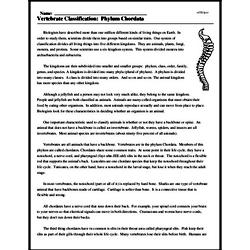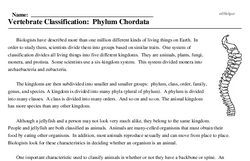Vertebrate Classification: Phylum Chordata
Biologists have described more than one million different kinds of living things on Earth. In order to study them, scientists divide them into groups based on similar traits. One system of classification divides all living things into five different kingdoms. They are animals, plants, fungi, monera, and protista. Some scientists use a six-kingdom system. This system divided monera into archaebacteria and eubacteria.
The kingdoms are then subdivided into smaller and smaller groups: phylum, class, order, family, genus, and species. A kingdom is divided into many phyla (plural of phylum). A phylum is divided into many classes. A class is divided into many orders. And so on and so on. The animal kingdom has more species than any other kingdom.
Although a jellyfish and a person may not look very much alike, they belong to the same kingdom. People and jellyfish are both classified as animals. Animals are many-celled organisms that must obtain their food by eating other organisms. In addition, most animals reproduce sexually and can move from place to place. Biologists look for these characteristics in deciding whether an organism is an animal.
One important characteristic used to classify animals is whether or not they have a backbone or spine. An animal that does not have a backbone is called an invertebrate. Jellyfish, worms, spiders, and insects are all invertebrates. Most animal species are invertebrates (about ninety-five percent of all animals).




